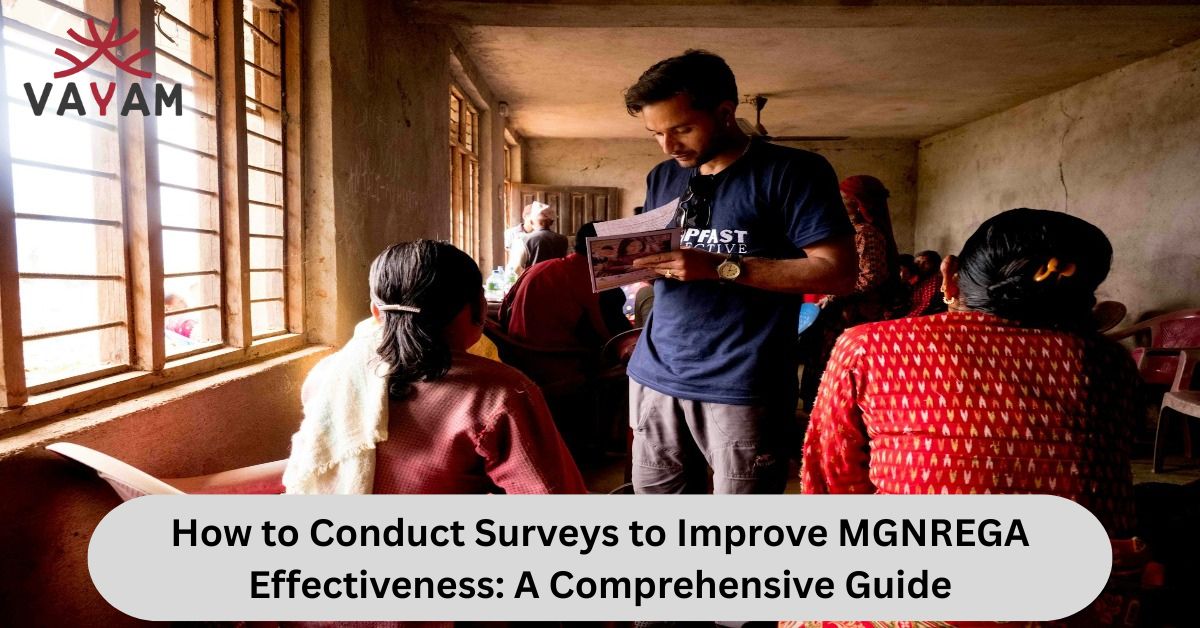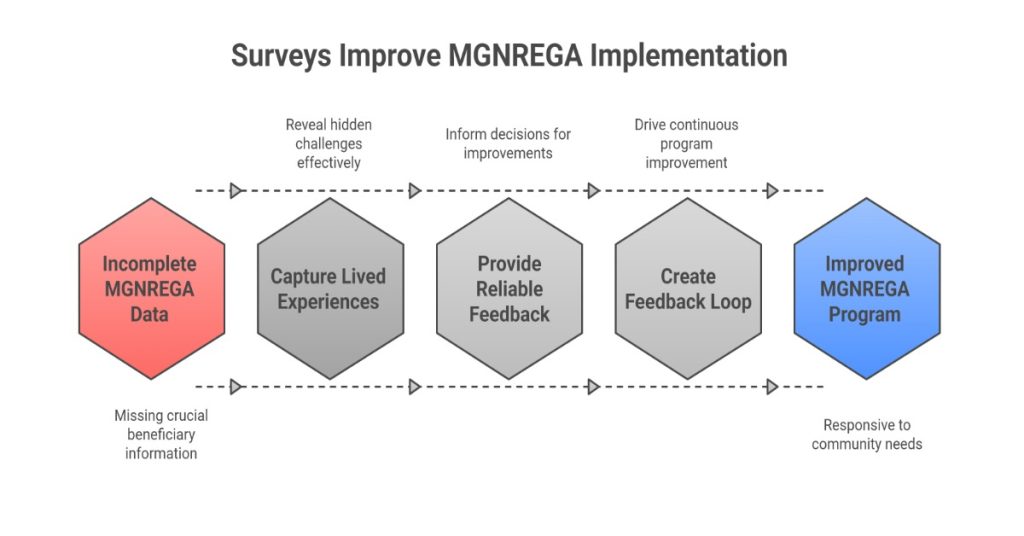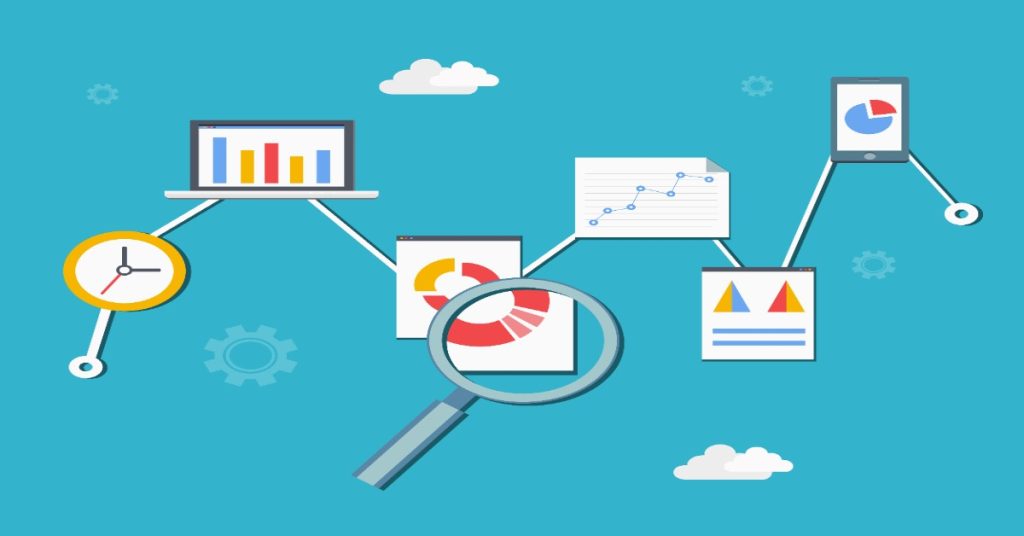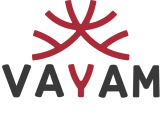
The Mahatma Gandhi National Rural Employment Guarantee Act (MGNREGA) stands as one of the world’s largest social protection programs, guaranteeing 100 days of wage employment to rural households. Yet, its effectiveness varies dramatically across regions.
The key to unlocking MGNREGA’s full potential lies in understanding ground realities through systematic surveys. Well-designed surveys bridge the gap between policy intentions and actual implementation.
This guide explores practical strategies for conducting surveys that generate actionable insights to enhance MGNREGA’s impact on rural livelihoods.
Why Surveys Matter for MGNREGA Implementation?
The Data Gap Challenge
Official MGNREGA data often paints an incomplete picture. Administrative records show work allocated and wages paid, but miss crucial aspects like work quality, beneficiary satisfaction, and actual socio-economic impact.
Surveys fill these critical information gaps by capturing lived experiences of job card holders. They reveal hidden challenges that statistics alone cannot uncover.
Building Evidence for Better Decisions
Panchayat leaders and block development officers need reliable feedback to make informed decisions. Surveys provide this evidence base, highlighting what works and what needs immediate attention.
Regular survey cycles create a feedback loop that drives continuous improvement. They transform MGNREGA from a static scheme to an evolving program responsive to community needs.

Types of Surveys Essential for MGNREGA Assessment
Beneficiary Satisfaction Surveys
These surveys directly engage job card holders to understand their experiences. Key areas include wage payment timeliness, work allocation fairness, and worksite conditions.
Questions should explore both quantitative metrics (days worked, wages received) and qualitative aspects (treatment by officials, work meaningfulness).
Work Quality Assessment Surveys
Asset creation under MGNREGA requires quality verification. Surveys should evaluate durability of constructed assets, their utility for communities, and maintenance provisions.
Technical assessments combined with community feedback provide a complete picture of asset effectiveness.
Process Evaluation Surveys
Understanding implementation processes helps identify bottlenecks. These surveys examine job card registration procedures, work demand mechanisms, and grievance redressal systems.
Process mapping through surveys reveals where simplification or digitization could improve efficiency.
Step-by-Step Survey Methodology
Phase 1: Planning and Design
Start by defining clear objectives. What specific aspects of MGNREGA need improvement? Your objectives shape everything from sample size to question design.
Develop a sampling strategy that ensures representation across different social groups, geographic areas, and work types. Random sampling within stratified groups often works best.
Phase 2: Questionnaire Development
Create questionnaires in local languages using simple, unambiguous language. Avoid leading questions that might bias responses.
Include a mix of closed-ended questions for quantitative analysis and open-ended questions for deeper insights. Pre-test questionnaires with a small group to identify confusing elements.

Phase 3: Surveyor Training
Invest heavily in training survey teams. They need to understand MGNREGA provisions, interview techniques, and ethical considerations.
Role-playing exercises help surveyors practice handling different scenarios. Emphasize the importance of neutrality and active listening.
Phase 4: Field Implementation
Schedule surveys considering agricultural seasons and local festivals. Morning hours often work best before people leave for work.
Maintain quality through spot checks and back-checks. Random revisits to 5-10% of respondents help verify data accuracy.
Phase 5: Data Management
Establish clear protocols for data entry, cleaning, and storage. Digital data collection through tablets reduces errors and speeds processing.
Create backup systems to prevent data loss. Cloud storage with proper encryption ensures security and accessibility.
Innovative Survey Tools and Techniques
Digital Survey Platforms
Mobile applications like ODK Collect and SurveyCTO enable offline data collection with GPS tagging and photo documentation. These tools reduce paperwork and improve accuracy.
Real-time data syncing allows supervisors to monitor progress and quality remotely.
Participatory Methods
Focus group discussions complement individual surveys. They reveal community dynamics and collective concerns that individual interviews might miss.
Social mapping exercises help understand work allocation patterns and identify excluded groups.
Audio-Visual Documentation
Recording video testimonials (with consent) creates powerful evidence for advocacy. Photos of worksites provide visual verification of reported conditions.
Time-lapse photography can document asset creation progress and quality over time.

Ensuring Survey Quality and Reliability
Addressing Respondent Bias
People may fear negative consequences for critical feedback. Guarantee anonymity and explain how survey results will be used for improvement, not punishment.
Conduct surveys away from government offices or authority figures’ presence. Neutral venues encourage honest responses.
Managing Surveyor Bias
Surveyors’ personal views shouldn’t influence data collection. Regular debriefing sessions help identify and address emerging biases.
Rotating surveyor assignments prevents them from developing preferences for certain areas or groups.
Validation Strategies
Cross-verify survey findings with administrative data, social audit reports, and third-party assessments. Triangulation strengthens credibility.
Physical verification of reported assets adds another validation layer. GPS coordinates and photographs provide objective evidence.
Key Survey Questions for Maximum Impact
Employment Access Questions
- How many days of work did you request versus receive?
- What barriers prevented you from getting desired work days?
- How far do you travel to worksites?
These questions reveal gaps between demand and supply of work.
Wage Payment Questions
- How long after work completion do wages arrive?
- Through what mode do you prefer receiving wages?
- Have you faced any wage payment irregularities?
Payment delays remain a persistent challenge requiring monitoring.
Asset Utility Questions
- Which MGNREGA assets benefit your household most?
- Are completed assets being maintained properly?
- What additional assets would address community needs?
Understanding asset preferences helps prioritize future work.

Data Analysis for Actionable Insights
Quantitative Analysis Techniques
Calculate key performance indicators like average wage delay, work completion rates, and satisfaction scores. Compare these across blocks and social groups.
Regression analysis can identify factors most strongly associated with program success or failure.
Qualitative Data Processing
Code open-ended responses to identify recurring themes. Word clouds and sentiment analysis reveal common concerns and suggestions.
Case studies of exceptional performers provide replicable good practices.
Visualization for Impact
Create dashboards showing survey results through maps, charts, and infographics. Visual presentations engage policymakers more effectively than lengthy reports.
Interactive visualizations allow users to explore data based on their interests.
From Survey Findings to Program Improvements
Developing Action Plans
Prioritize issues based on severity and feasibility of solutions. Quick wins build momentum for larger reforms.
Create specific, measurable targets for improvement. “Reduce wage delays to under 15 days” is better than “improve wage payments.”
Stakeholder Engagement
Share findings with gram panchayats, beneficiaries, and implementing agencies. Collaborative problem-solving generates local ownership.
Public display of survey results promotes transparency and accountability.
Monitoring Implementation
Track whether recommended changes are implemented. Follow-up surveys measure actual impact of interventions.
Document successful innovations for replication elsewhere.

Addressing Common Survey Implementation Challenges
Resource Constraints
Limited budgets require creative solutions. Partner with local colleges for student volunteers or collaborate with NGOs already working in target areas.
Phased implementation allows spreading costs over time while building capacity gradually.
Geographic and Cultural Barriers
Remote areas need special strategies like mobile survey camps or trained local facilitators. Understanding cultural sensitivities prevents offending respondents.
Schedule flexibility accommodates local customs and agricultural cycles.
Political Sensitivity
MGNREGA surveys can reveal uncomfortable truths. Build consensus on survey objectives beforehand and emphasize improvement over blame.
Include diverse stakeholders in survey design to ensure buy-in for findings.
Best Practices from Successful MGNREGA Surveys
Andhra Pradesh’s Real-Time Monitoring
The state uses mobile apps for instant beneficiary feedback at worksites. This immediate data collection reduces recall bias and enables quick corrective action.
Weekly analysis of survey data drives regular review meetings at all levels.
Rajasthan’s Social Audit Integration
Surveys complement social audits by providing confidential feedback channels. This dual approach captures both public and private concerns.
Youth volunteers trained as surveyors create local employment while gathering data.
Kerala’s Participatory Planning
Surveys inform ward-level planning meetings where communities prioritize works. This bottom-up approach ensures selected projects address real needs.
Gender-disaggregated data highlights women’s specific requirements.

Measuring Long-Term Impact Through Surveys
Longitudinal Studies
Track the same households over multiple years to understand MGNREGA’s cumulative impact. This reveals whether benefits sustain or fade over time.
Panel surveys show how program participation affects migration, education, and asset accumulation.
Impact Evaluation Design
Compare similar villages with different MGNREGA implementation quality. This quasi-experimental approach isolates program effects from other factors.
Before-after comparisons around major policy changes measure reform effectiveness.
Sustainability Assessment
Survey whether created assets remain functional years later. Evaluate community ownership and maintenance mechanisms.
Assess whether MGNREGA work builds skills enabling better employment opportunities.
FAQ
What are the main challenges in conducting MGNREGA surveys?
The primary challenges include reaching remote villages, overcoming respondent hesitation, ensuring data accuracy, and managing survey costs. Language barriers and low literacy levels add complexity.
What ethical considerations apply to MGNREGA surveys?
Obtain informed consent before surveying. Explain data usage clearly and respect refusals to participate.
Protect respondent identities, especially when discussing sensitive issues like corruption or discrimination. Store data securely and limit access to authorized personnel only.
Weather conditions affect fieldwork timing, especially during monsoons. Building trust with communities takes time but is essential for honest responses.
How can technology improve MGNREGA survey efficiency?
Digital surveys reduce costs by 30-40% compared to paper-based methods. GPS-enabled devices ensure accurate location data and prevent fake entries.
Automated analysis tools process data faster, enabling quicker response to identified problems. Machine learning can predict potential issues before they become critical.
What sample size is adequate for MGNREGA surveys?
For district-level insights, aim for 400-500 households minimum. This provides reasonable statistical confidence while remaining manageable.
Ensure at least 30 respondents from each major social group for meaningful sub-group analysis. Smaller samples work for rapid assessments or pilot studies.
How frequently should MGNREGA surveys be conducted?
Ideally, conduct comprehensive surveys annually with rapid assessments quarterly. This frequency balances resource constraints with the need for timely feedback.
Seasonal variations mean some issues only appear at certain times. Multiple survey rounds capture these temporal dynamics.
Read More
Understanding Role of Panchayats in MGNREGA Implementation
The Environmental Impact of MGNREGA: Building Sustainable Communities
Top 5 MGNREGA Success Stories You Need to Know
Conclusion: Surveys as Catalysts for MGNREGA Transformation
Systematic surveys transform MGNREGA from a mere employment scheme to a responsive development program. They provide the evidence base for continuous improvement and innovation.
The investment in quality surveys pays dividends through better targeting, reduced leakages, and enhanced beneficiary satisfaction. Most importantly, surveys give voice to rural workers whose feedback shapes program evolution.
Start small with pilot surveys in selected blocks. Build capacity gradually while demonstrating value through quick wins. Over time, institutionalize survey systems as integral to MGNREGA governance.
Remember, the goal isn’t perfect data but actionable insights. Even simple surveys, conducted regularly with community participation, can dramatically improve MGNREGA’s effectiveness in transforming rural livelihoods.
The path to MGNREGA excellence runs through systematic listening to beneficiary voices. Surveys provide the structured mechanism for this essential dialogue between citizens and the state.
